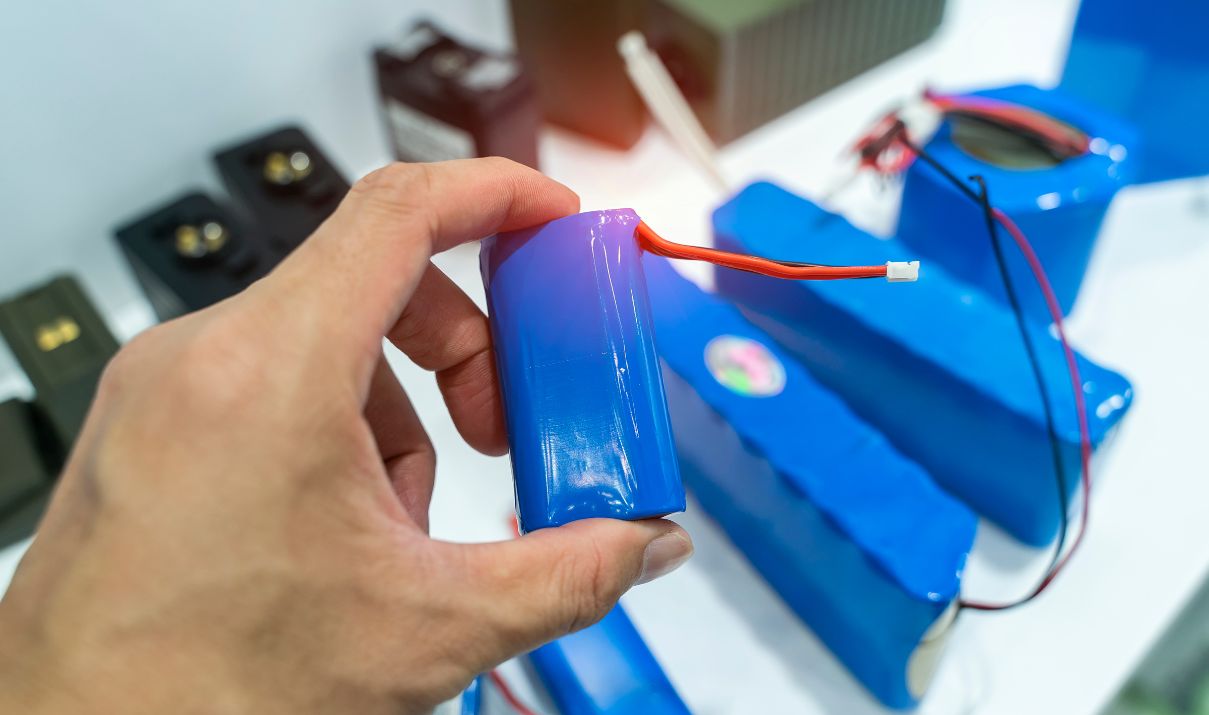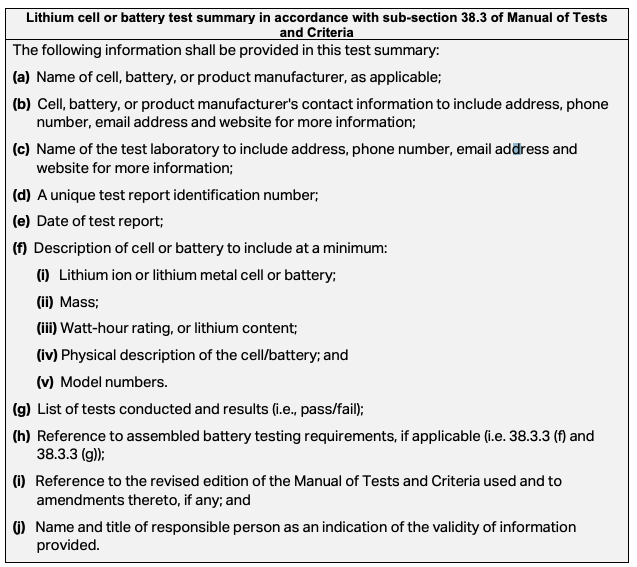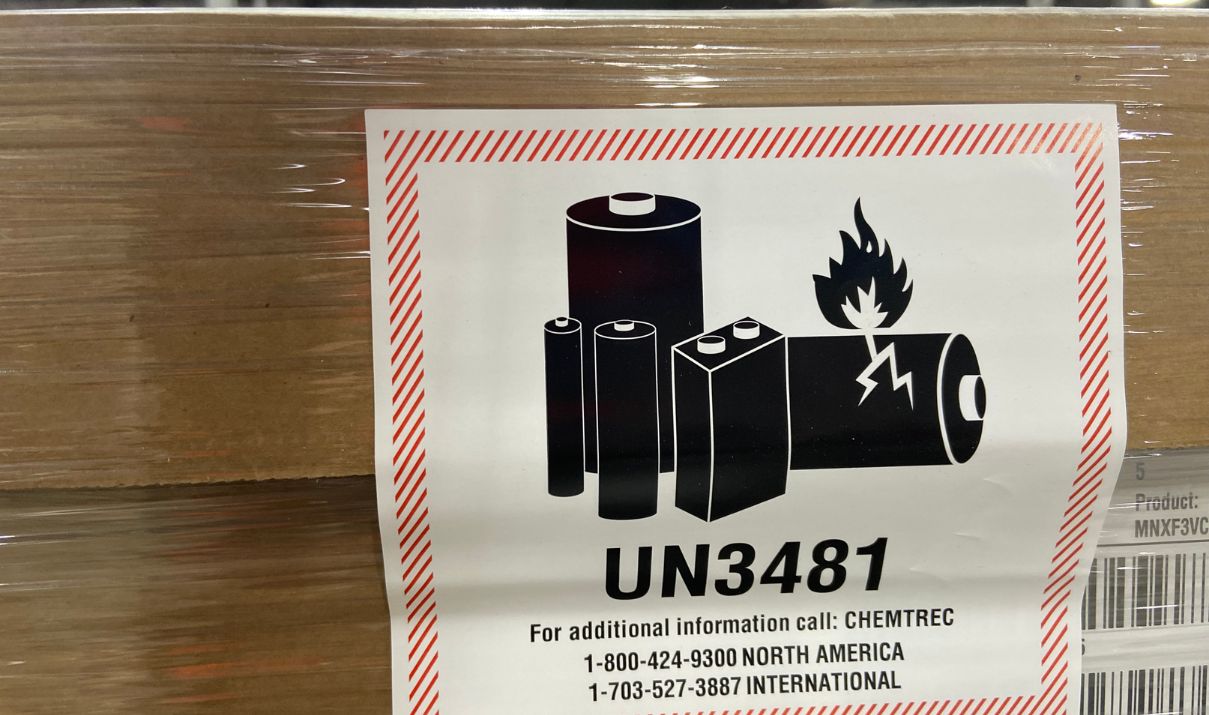Few challenges are as dynamic and complex as the transportation of lithium-ion (Li-ion) batteries. These batteries come with their own unique set of complexities, and not all logistics services providers have the specialized knowledge required for safe and compliant handling.
In our previously written primer on Shipping Lithium-Ion Batteries Internationally, we covered the fundamentals of this intricate task. In this more comprehensive guide, we will take a deeper dive, exploring the precise requirements, regulations and best practices necessary for the secure and compliant shipping of lithium-ion batteries.
Understanding Lithium-Ion Batteries
Lithium-ion batteries are the foundation of modern power storage, serving various industries, from consumer electronics and automotive to industrial applications. Their lightweight and high-energy density make them a preferred choice for applications that demand portable, long-lasting power. And the number of products relying on Li-ion batteries is only continuing to grow.
However, when it comes to safe shipping, it’s important to delve into the classification of lithium-ion batteries. These energy powerhouses fall under Hazmat Class 9 within the dangerous goods system that assesses substances and materials based on their potential risks during transportation. Hazmat Class 9 covers miscellaneous hazardous materials, including items prone to overheating and flammability. Li-ion batteries are particularly significant in this category due to their fire hazard potential and vulnerability to overheating.
These classifications provide a framework for shippers to identify and handle lithium-ion batteries properly, ensuring compliance with safety regulations and preventing accidents during transportation. Lithium-ion batteries may be common, but their classification as Hazmat Class 9 dangerous goods highlights the importance of adhering to strict safety measures. Mishandling, improper packaging or storage can result in severe chemical and electrical hazards. Therefore, an in-depth understanding surrounding the specifics of safe shipping is critical.

Chemical composition: Lithium-ion batteries contain a mix of highly reactive materials. Understanding the chemistry is crucial for effectively handling potential risks.
Energy density: The high energy density means they pack a lot of power into a relatively small space. This concentration of energy increases the potential consequences of mishandling during shipping.
Thermal management: Lithium-ion batteries can generate heat during operation, and this heat can be a safety concern, especially in enclosed spaces like shipping containers.
Electrical characteristics: Shipping involves managing electrical properties like voltage and current, which can impact safety if not controlled properly.
Safety measures: A thorough understanding of how to handle, label, and package lithium-ion batteries is critical to avoid incidents or accidents during transit.
Lithium-Ion battery shipping regulations
When shipping Li-ion batteries via air, sea, rail, or road, compliance with the United Nations Standard 38.3 is a critical requirement. This standard, a part of the UN Manual of Tests and Criteria, applies to both standalone batteries and those integrated into devices. For over 30 years, the United Nations has issued guidelines for the secure transport of hazardous materials.
These guidelines align with the Globally Harmonized System of Classification and Labelling of Chemicals (GHS), providing a universal safety code for chemicals. This approach simplifies the understanding of potential risks associated with different chemicals, regardless of geographic location, ensuring the safe handling, transport, and utilization of chemicals while safeguarding both people and the environment.
Keeping Pace with Evolving Regulations
The landscape of lithium-ion battery shipping regulations is constantly evolving. As of May 2024, shippers should be aware of the latest updates in the 2024 Edition of the IATA Lithium Battery Guidance Document. This edition may introduce revisions to packaging requirements, labeling procedures, or allowances for specific battery types compared to the 2023 version.
For instance, the new guidance might specify the use of fire-resistant inner packaging materials for batteries exceeding a certain Wh rating. Remember, staying informed and compliant with the latest regulations is vital to ensure the safe and smooth transport of your lithium-ion batteries
UN Standard 38.3: A global benchmark
The UN Manual of Tests and Criteria provides meticulous test methodologies, criteria, and procedures for the classification of dangerous goods. Within this comprehensive regulatory framework lies a dedicated section, UN Standard 38.3, specifically tailored to address the transportation of lithium metal and lithium-ion batteries. These regulations serve as a global benchmark, preserving the safety of shipping lithium-ion batteries, and are widely accepted from regulatory authorities around the world.
Meeting the distinctive restrictions
If you’re considering shipping lithium-ion batteries internationally, it’s imperative to understand the distinctive restrictions stemming from the inherent hazards they pose. These specific requirements may vary depending on the mode of transportation and the country or countries in which the batteries are being transported. It’s advisable to consult with the relevant authorities to ensure compliance. Li-ion batteries undergo rigorous testing to meet the requisites outlined in UN Standard 38.3.
Lithium-Ion battery tests: ensuring safe transportation
UN 38.3 outlines 8 tests designed to ensure the safe transport of Li-ion batteries without compromising their integrity. These individual assessments serve as a safeguard against potential risks during transit, testing factors such as reactions to extreme temperature and altitude changes.
Test 1 Altitude Simulation: Replicates the conditions of air transport at high altitudes with low pressure, ensuring the battery’s performance in these circumstances.
Test 2 Thermal: Evaluates the integrity of cell and battery seals, as well as internal electrical connections, by subjecting the batteries to rapid and extreme temperature fluctuations.
Test 3 Vibration: Simulates the vibrations batteries might encounter during transport.
Test 4 Shock: Measures the batteries’ resilience against cumulative shocks, evaluating their ability to withstand mechanical impact.
Test 5 External Short Circuit: Replicates external short-circuit conditions to assess the batteries’ safety.
Test 6 Impact/Crush: Designed to simulate mechanical abuse from impacts or crushing, this test evaluates the risk of internal short circuits.
Test 7 Overcharge: Assesses the ability of rechargeable batteries to endure overcharging conditions without compromising safety.
Test 8 Forced Discharge: Evaluates the capability of primary or rechargeable cells to withstand forced discharge conditions under extreme circumstances.

Required test summaries
Prior to 2019, shippers were only required to confirm that batteries had passed the UN 38.3 test. However, since January 21, 2022, lithium cell and battery manufacturers and distributors must have test summaries available. The updated UN guidelines incorporate a consolidated summary of lithium-ion battery testing and following test completion, a report summary is mandatory.

Drop Test
Drop tests are an integral component of UN specification packaging performance evaluations. They are designed to determine if the packaging can endure the impact of being dropped from a designated height. These tests are conducted with the battery packaging being dropped in various orientations. Detailed specifications and guidelines for drop tests can be found in IATA’s Lithium Battery Shipping Regulations.
Transportation and handling
Shipping lithium-ion batteries safely and efficiently requires a comprehensive understanding of the intricate web of regulations and guidelines that govern their transport. Different modes of transportation, including air, sea, and road, have their own distinct rules to ensure the secure movement of these essential power sources.
International regulations
International shipment varies depending on the country. In the United States, regulatory responsibility for lithium batteries falls under the Department of Transportation (DOT). The primary agency within the DOT is the Pipeline and Hazardous Materials Safety Administration (PHMSA). The shipment of batteries from international locations to the US is subject to oversight from organizations like the International Maritime Organization (IMO), the United Nations (UN), and the European Union (EU).
Shipping by air
Certain rules and restrictions are in place to ensure safety for air shipments. Standalone Li-ion batteries cannot be transported as cargo on passenger flights. However, Li-ion batteries that are integrated into equipment can be shipped by air, with limitations on the quantity of batteries and the type of equipment they are installed in.
For standalone lithium-ion batteries, bulk shipment via cargo aircraft is possible, but they must be packed in an approved manner to prevent short circuits. This includes individually packaging each battery and placing them in a secondary outer packaging designed to prevent short circuits.
All lithium-ion cells and batteries (UN 3480 only) must be shipped at a state of charge (SoC) not exceeding 30% of their rated capacity. Cells and batteries with a SoC greater than 30% may only be shipped with the approval of the State of Origin and the State of the Operator, under the written conditions established by those authorities (refer to Special Provision A331). For the most up-to-date and revised regulations, refer to the 2024 IATA Lithium Battery Guidance Document. Whether shipments are international or domestic, it’s best to check with the air carrier for any additional requirements.
Shipping by sea
When it comes to international shipping of lithium-ion batteries, ocean freight is the primary mode of transportation. This method is subject to regulations outlined in the International Maritime Dangerous Goods Code (IMDG Code), which serves as the global standard for the safe transport of hazardous materials by sea.
Shippers can find comprehensive guidelines for shipping lithium-ion batteries in containers within the DOT’s Lithium Battery Guide. These guidelines are essential for ensuring the safe and compliant transport of these batteries.
Essential Considerations for Safe Ocean Transport
Container Requirements: Containers used for shipping lithium-ion batteries by sea must meet specific IMDG Code regulations. These regulations may include requirements for proper ventilation, fire-resistant lining, and segregation from incompatible cargo to minimize risks during transport. Consulting with a qualified shipping company or packaging expert can ensure your containers meet all necessary specifications.
Declaration and Documentation: Accurate declaration and complete documentation are crucial for smooth sailing. Shippers must clearly declare the contents of their shipment, including the type and quantity of lithium-ion batteries, their UN numbers, and classification details. Failure to provide accurate information can lead to delays, fines, or even shipment rejection at the port.
Partnering with a Shipping Expert: The complexities of IMDG Code regulations and proper handling procedures can be daunting for some shippers. Partnering with a reputable shipping company experienced in handling hazardous materials like lithium-ion batteries can provide peace of mind. These experts can ensure your Li-ion batter shipping adheres to all IMDG Code requirements and is handled with the utmost care throughout the entire shipping process.
Shipping by road
In the United States, shippers must follow the Department of Transportation’s (DOT) regulations for lithium-ion batteries. This includes proper packaging, labeling and the specific quantity and type that can be transported on the road. The trucking company must also follow the DOT regulations to put the placards on the outside containers.
The cost of shipping by air
- Li-ion batteries are relatively heavy and dense, which directly impacts the cost of air transportation. Airlines calculate fees based on the weight and volume of shipments, making heavier and denser shipments more expensive to transport.
- Li-ion batteries require special handling when being transported by air. For example, they must be separated from other hazardous materials and loaded and unloaded from aircraft carefully.
- The distance between the origin and destination of the shipment can also affect the cost.
- During times of high demand, shipping rates may be higher.
- When fuel prices are high, airlines may pass on some of these costs to their customers.
To reduce the expense of shipping lithium-ion batteries by air, consider the following:
- Use a freight forwarder: Freight forwarders can help you negotiate shipping rates with airlines and can also help you to consolidate shipments, which can save you money on shipping costs.
- Ship in bulk: This can help you to reduce the cost per unit.
- Avoid peak shipping times: Shipping rates tend to spike during peak times, such as the holiday season.
Packaging Lithium-Ion Battery Shipments
To ensure the safe and compliant transport of Li-ion batteries by air, proper packaging is essential. How these batteries are shipped dictates specific packaging and labeling requirements, and shippers must obtain certification to handle dangerous goods and adhere to relevant regulations. Here are key packaging requirements:
Non-Metallic Inner Packaging: Batteries should be placed in non-metallic inner packaging that fully encloses each cell or battery. This packaging also serves to separate them from electrically conductive materials, such as metal.
Preventing Shifting: It’s crucial to pack Li-ion batteries to prevent shifting during transit, which could otherwise cause damage to the batteries or surrounding cargo.
Secure Fastening: When shipping electric vehicle (EV) batteries contained in vehicles or equipment, they must be securely fastened within the equipment.
United Nations numbers for lithium battery shipments
In addition to proper packaging, lithium battery shipments are subject to UN regulations, which mandate specific markings. UN numbers are four-digit identifiers that indicate whether the items are hazardous substances or dangerous goods. These markings include the UN identification number, which varies depending on the type of lithium batteries being shipped:
UN3480: Lithium-ion batteries shipped by themselves (rechargeable).
UN3481: Lithium-ion batteries packed with or contained in equipment.
UN3090: Loose lithium metal batteries shipped by themselves (non-rechargeable).
UN3091: Lithium metal batteries “packed with” or “contained in” equipment.
Lithium-ion shipping label requirements
When it comes to packaging labels, requirements may vary, especially when shipping in small quantities. It’s essential to review the specific requirements applicable to your shipment, ensuring compliance with all regulations.
On the outer packaging, carriers expect to find the following:
- Identification of the cargo type (e.g., lithium–ion batteries)
- Class 9 lithium battery label
- UN DG identification number
- Shipper or recipient’s name and address
- Emergency contact information
These markings should be applied or printed in a durable manner, ensuring legibility and the ability to withstand various environmental conditions. Proper labeling not only enhances safety but also expedites customs clearance and ensures that your shipment arrives at its destination without unnecessary delays or issues.
Dealing with defective and damaged batteries
Defective, damaged, or recalled (DDR) lithium batteries pose an elevated risk during transportation, regardless of the mode, size, or quantity. Identifying such batteries can be challenging. The Pipeline and Hazardous Materials Safety Administration of the Department of Transportation (DOT) emphasizes that inadequate awareness and information might lead many shippers and carriers to transport DDR Li-ion batteries in the same manner as non-DDR ones, amplifying risks. Any damaged Li-ion battery is forbidden from transport on an aircraft.
The importance of cargo insurance
Transporting hazardous materials, like lithium-ion batteries, carries higher risks compared to general cargo. These batteries can overheat, catch fire, or even explode, making your shipment susceptible to various hazards during transit. Additionally, the risk of fire during the international shipping of lithium-ion batteries may result in liabilities for nearby cargo that may also be damaged.
Relying solely on steamship lines or trucking companies to handle these risks is unwise. Notably, shipping batteries by air and, especially, by sea has led to multiple container fires. Safeguarding your financial interests and cargo through comprehensive cargo insurance is essential in mitigating these substantial risks.
Confidently safeguard your international lithium-ion battery shipments
As our reliance on Li-ion batteries grows, so does the responsibility to transfer them safely and responsibly. By understanding these regulations and guidelines, and by staying updated with evolving standards, shippers can not only protect their cargo but also the well-being of all those who come in contact with these energy sources.
In this comprehensive guide, we’ve delved into the intricacies and regulations surrounding shipping Li-ion batteries. Navigating this complex landscape requires expertise and a commitment to compliance. Don’t leave the safety and reliability of your shipments to chance.
At Dimerco Express Group, we specialize in the safe and efficient transport of lithium-ion batteries. Our experienced team understands the unique challenges and regulatory requirements of battery shipping, ensuring your cargo reaches its destination securely and in full compliance with international standards.
Don’t risk delays, rejections, or potential liabilities. Partner with Dimerco Express Group to streamline your lithium-ion battery shipments. Contact us today for a tailored solution that prioritizes safety, compliance and efficiency in your supply chain.

